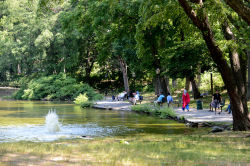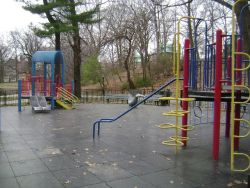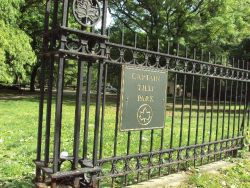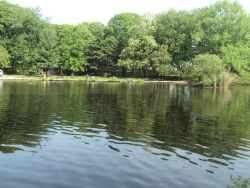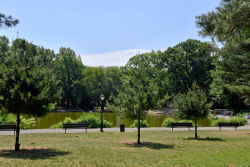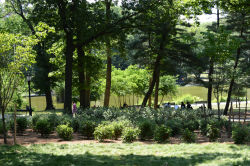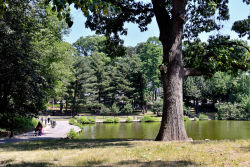Captain Tilly Park
Captain Tilly Park
What was here before?
The Tilly family once owned the land on which this park sits. At the turn of the 20th century the bulk of the wooded land and Goose Pond which comprise Captain George H. Tilly Park was owned by the Highland Park Society, a group of Jamaica landowners who raised ducks and geese at the site.
How did this site become a park?
In 1908, the landowners deeded the property to New York City for one dollar, insisting that it always be used as a park. The park was first named Highland Park and renamed Upland Park in 1912 to avoid confusion with Highland Park in Cypress Hills. In 1935, city officials renamed the property to honor local war hero Captain George Tilly.
In 1941, a monument dedicated to the “heroes of the Spanish-American War” was erected in the park by the Captain George H. Tilly Camp No. 66 of Jamaica.
Over the years, there have been several renovations to the park. By 1995 the springs that fed the pond had dried up and the pond was covered with an algae bloom. Members of the Jamaica Hill Community Association excavated and deepened the pond, installed a new clay liner and filtration system to keep the water clean, dug a well, constructed an island in the pond to provide a refuge for wildlife, and extended the playground.
In 2015 and 2017 the park was reconstructed in two phases with updated landscaping to prevent future erosion. The public restroom was rebuilt in 2024.
Who is this park named for?
Captain George H. Tilly Park is named for a local son of a prominent Jamaica family who was killed while fighting in the American colonization of the Philippines in 1899.
Captain Tilly (1863-1899) was assigned to the Army Signal Corp and stationed at Lloilo, Philippines, on the Isle de Panay during the war. By provision of the Treaty of Paris in 1899, the United States annexed the Philippine Islands, a former Spanish colony, as a prize for its victory over Spain in the Spanish-American War (1898). Having removed Spanish rule, the United States sought to impose its own will upon the Philippines but met resistance from Filipino rebels seeking independence from foreign rule.
On May 22, 1899, Tilly and a small group about the steamer Recorder were dispatched to Escalante on the Isle de Negros to repair a damaged telegraph cable. Although Captain Tilly and his landing party were informed that the residents of Escalante were peaceful, he was warned nonetheless not to wear his uniform upon landing to avoid inflaming resentment. Ignoring the warning, Tilly and his group landed and proceeded to the island’s cable office. Once inside the building, they were fired upon from all sides and quickly returned to the beach and their launch. Some of Tilly’s men panicked and put the launch to sea before Tilly and the rest of the party arrived. Tilly and the remaining men swam for the launch under fire, and all but Tilly reached the boat safely. His body was later recovered and buried nearby.
Check out your park's Vital Signs
Clean & Safe
Green & Resilient
Empowered & Engaged Users
Share your feedback or learn more about how this park is part of a
Vital Park System

